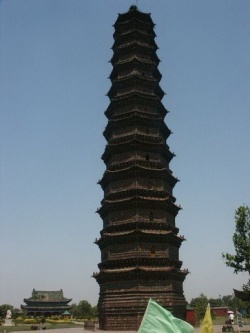Tower in Youguo Temple
The Tower in the Youguo Temple is located in the northeast of Kaifeng City, Henan Province.
The tower is also called Iron Tower because its Body is inlaid with brown glazed tiles, looking like the color of iron. The Iron Tower was first built in the Kaibao Temple. In the Song Dynasty (960-1279), the temple was grand in scale and halls amounted to 280, including 24 Monasteries. The imperial examination center was also set here to select the talents from the students recommended from all over The country. The emperors of the Northern Song Dynasty (960-1127) often paid visits to the temple, and therefore the temple was named after the reign of Kaibao. At that Time, the Kaibao Temple was eminent and influential, and once became one of the famous temples in the Central Plains.
The Youguo Temple, originally made of woods, is octagonal and 120 meters high with 13 storeys. It is said that the Mastery artisan Yu Hao was in charge of its construction. The tower was burnt out by a thunder in the 4th year (1044) of the Qingli reign in the Northern Song Dynasty, and rebuilt in the first year (1049) of the Huangtuo reign. In the 21st year (1841) of the Daoguang reign in the Qing Dynasty (1644-1911), the overflow of the Yellow River destroyed all the temples in Kaifeng City, however only the Youguo Temple was safe and Sound.
The Iron Tower is 55 meters high, octagonal and 13-storeyed. It is a brick tower in the style of a wooden pavilion. The inside is built by laying bricks while the outside is built by wooden structures such as doors and windows, poles, arches, eaves, the base and so on. The whole tower consists of 28 different brick components. The exterior of the tower is inlaid with beautiful glazed tiles, on which are more than 50 patterns such as flying Apsaras, kylins, roaming Dragons, valiant lions, sitting Buddha, standing Monks, singers and dancers, Flowers and Plants, and so on. They are rich in contents, and exquisite in techniques, which are the elaborate works of the brick carvings. With upturned eaves and lifted angles, the tower appears elegant and upright. The spiral stone staircase inside closely connects the central pole and the exterior into a whole, which greatly strengthens the anti-seismic capability of the tower. During the past more than 900 years, the Iron Tower went through numerous earthquakes, floods, and wars and still stand there intact. Along the stone steps, one can reach the top of the tower. Leaning on the railings and looking to the distance, he/she will certainly have a panoramic view of the styles and features of the old city. The scenery of clouds floating around the tower has been one of the famous eight scenes in Kaifeng since the Song Dynasty.
